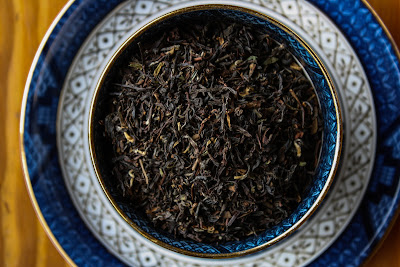Here in the PNW, early Spring has most definitely arrived. I'm constantly craving high mountain (high caffeine) black teas and walks outside with the fragrant flowers, the sunshine and my maniac dog and child. Erik is craving steamed green teas, quiet afternoons in coffee shops and art museum exploration. Let's take a look at our favorites for the season!
Friday wants...
Darjeelings are known as "the champagne of tea" for a reason. These are floral and delicate, but with complex flavor profile. Be careful, though. Helluva caffeine kick on these! Personally, I can have only a couple demitasse cups of this Makaibari Estate First Flush before I start to see through space and time. Dangerous, but so. Worth. It.
Serendipi-Tea is a silly little blend we stumbled upon accidentally a number of years ago. It's simple, light, and ideal for a long afternoon of conversation and/or art projects with loud children (in my case). Ceylon black tea is light-bodied and classic, whereas a lightly steamed oolong, such as this Ti Kwan Yin, is slightly floral, slightly malty, and only gets better the more time it's steeped! If you haven't tried this one, give it a shot.
Audrey's Spring Tea is the ideal tisane for this time of year. It's cheerful and bright, full of vitamin C and is delicious hot OR iced. If you like tart, fruity flavors and the color electric pink, try it out!
Bonus trivia: this was TeaBoy's first blend ever! He invented this one at age 6 and it's been our favorite this time of year ever since.
Erik wants...
Sencha is a classic, lightly vegetal Japanese green tea. Erik is all about the steamed greens this time of year. This is a complex, yet clean green. Light on the palate, grassy and reminiscent of Spring afternoons!
Queen of Hearts may be the ideal garden party tea. A light-bodied Ceylon black tea with warm floral rose notes and the woody bite of black peppercorn. We're all big fans of the floral/spicy combination!
Allyn wants...
Wonderland Blend is basically a fruit snack. Seriously. We put together blueberries, apple chunks and hibiscus petals for a bright purple infusion that smells and tastes amazing. It's a favorite for making iced tea and we occasionally even snack on it, trail mix style! This is definitely a winner for kids' tea parties, tisane popsicles and iced tea garden parties.
So there ya go. Six very different, very tasty, very versatile teas to try out this Spring! What's your favorite?
Happy sipping,
Friday
Friday wants...
Darjeelings are known as "the champagne of tea" for a reason. These are floral and delicate, but with complex flavor profile. Be careful, though. Helluva caffeine kick on these! Personally, I can have only a couple demitasse cups of this Makaibari Estate First Flush before I start to see through space and time. Dangerous, but so. Worth. It.
 |
| First Flush Darjeeling |
Serendipi-Tea is a silly little blend we stumbled upon accidentally a number of years ago. It's simple, light, and ideal for a long afternoon of conversation and/or art projects with loud children (in my case). Ceylon black tea is light-bodied and classic, whereas a lightly steamed oolong, such as this Ti Kwan Yin, is slightly floral, slightly malty, and only gets better the more time it's steeped! If you haven't tried this one, give it a shot.
 | ||
| Serendipi-Tea! |
Bonus trivia: this was TeaBoy's first blend ever! He invented this one at age 6 and it's been our favorite this time of year ever since.
 |
| Audrey's Spring Tea |
Erik wants...
Sencha is a classic, lightly vegetal Japanese green tea. Erik is all about the steamed greens this time of year. This is a complex, yet clean green. Light on the palate, grassy and reminiscent of Spring afternoons!
 |
| Sencha |
Queen of Hearts may be the ideal garden party tea. A light-bodied Ceylon black tea with warm floral rose notes and the woody bite of black peppercorn. We're all big fans of the floral/spicy combination!
 |
| Queen of Hearts |
Allyn wants...
Wonderland Blend is basically a fruit snack. Seriously. We put together blueberries, apple chunks and hibiscus petals for a bright purple infusion that smells and tastes amazing. It's a favorite for making iced tea and we occasionally even snack on it, trail mix style! This is definitely a winner for kids' tea parties, tisane popsicles and iced tea garden parties.
 |
| Wonderland Blend |
So there ya go. Six very different, very tasty, very versatile teas to try out this Spring! What's your favorite?
Happy sipping,
Friday
Comments
Post a Comment